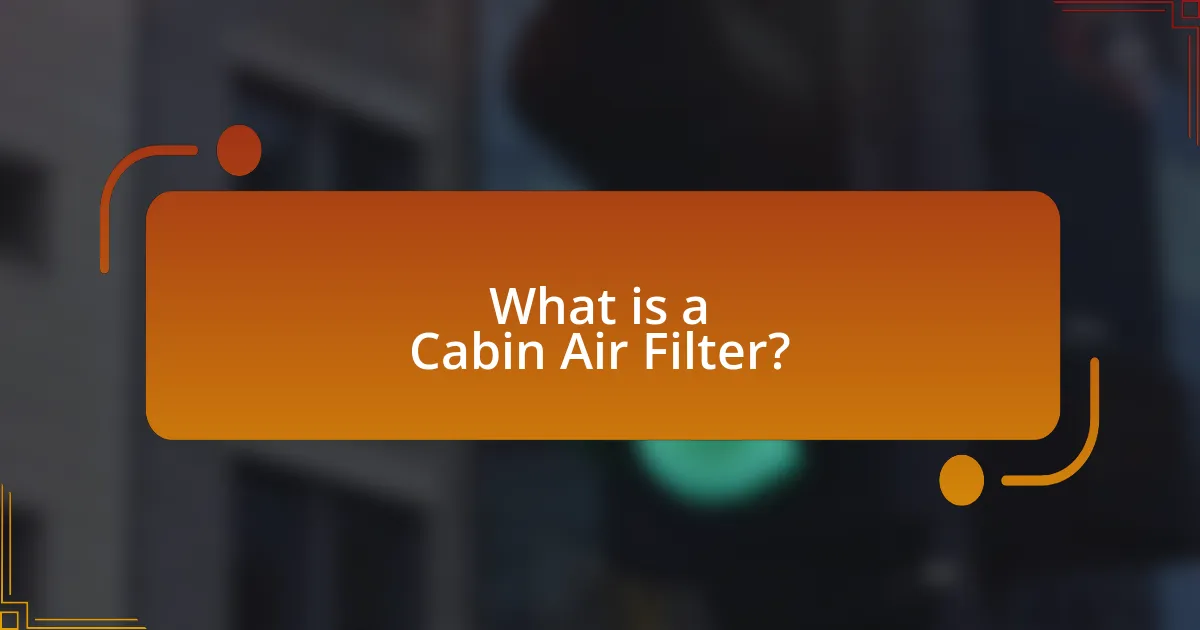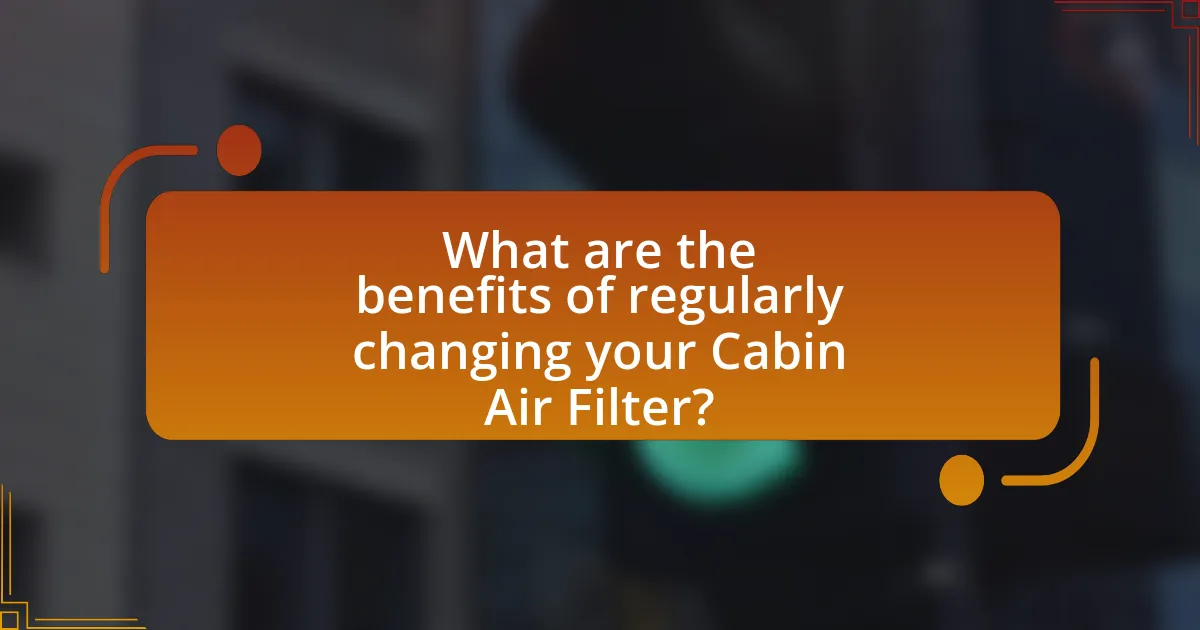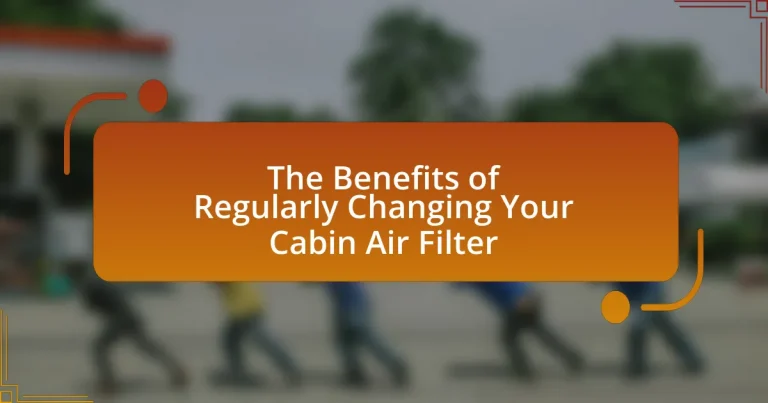The article focuses on the importance of regularly changing the cabin air filter in vehicles, a crucial component of the ventilation system that ensures cleaner air for passengers. It explains how the cabin air filter functions, its key components, and the significant impact it has on air quality, vehicle performance, and passenger health. The article emphasizes the health risks associated with a dirty filter, the financial benefits of regular maintenance, and provides guidelines on how often to change the filter, signs indicating a need for replacement, and best practices for the replacement process. Overall, maintaining a clean cabin air filter is essential for enhancing air quality, improving HVAC efficiency, and ensuring a comfortable driving experience.

What is a Cabin Air Filter?
A cabin air filter is a component in a vehicle’s ventilation system that filters the air entering the cabin from outside. This filter removes dust, pollen, and other airborne particles, ensuring that the air occupants breathe is cleaner and healthier. According to the American Lung Association, a clean cabin air filter can significantly improve air quality inside the vehicle, reducing allergens and pollutants that can cause respiratory issues. Regular replacement of the cabin air filter is recommended to maintain optimal air quality and system efficiency.
How does a Cabin Air Filter function in a vehicle?
A cabin air filter functions by trapping dust, pollen, and other airborne particles from the outside air before it enters the vehicle’s interior. This filtration process ensures that the air circulating within the cabin is cleaner and healthier for passengers. The filter is typically located in the vehicle’s HVAC (heating, ventilation, and air conditioning) system, where it intercepts contaminants as air is drawn in for heating or cooling. Regularly changing the cabin air filter is essential, as a clogged filter can reduce airflow and lead to unpleasant odors, while also compromising the effectiveness of the vehicle’s climate control system.
What are the key components of a Cabin Air Filter?
The key components of a cabin air filter include the filter media, frame, and sealing material. The filter media, often made from activated carbon or synthetic fibers, captures dust, pollen, and other airborne particles, ensuring clean air circulation within the vehicle. The frame provides structural support, allowing the filter to fit securely in the designated housing. The sealing material prevents unfiltered air from bypassing the filter, enhancing its efficiency. These components work together to improve air quality inside the vehicle, which is essential for passenger comfort and health.
How does the Cabin Air Filter impact air quality inside the vehicle?
The cabin air filter significantly impacts air quality inside the vehicle by trapping pollutants, allergens, and particulate matter from the outside air. This filtration process ensures that the air entering the cabin is cleaner and healthier for passengers. Studies indicate that a properly functioning cabin air filter can reduce the concentration of harmful substances, such as dust, pollen, and smoke, by up to 90%. Regularly changing the cabin air filter maintains its effectiveness, preventing the buildup of contaminants that can lead to respiratory issues and discomfort for occupants.
Why is it important to change your Cabin Air Filter regularly?
Changing your cabin air filter regularly is important because it ensures clean air circulation within the vehicle, enhancing the overall air quality for passengers. A clogged or dirty cabin air filter can lead to reduced airflow, increased allergens, and harmful pollutants entering the cabin, which can negatively impact health and comfort. Studies indicate that a clean cabin air filter can improve air quality by filtering out up to 99% of dust, pollen, and other airborne particles, thereby reducing respiratory issues and allergies among occupants. Regular replacement of the cabin air filter, typically recommended every 12,000 to 15,000 miles, helps maintain optimal performance of the vehicle’s HVAC system and prolongs its lifespan.
What are the potential health risks of a dirty Cabin Air Filter?
A dirty cabin air filter can lead to several potential health risks, including respiratory issues, allergic reactions, and exacerbation of existing health conditions. When the filter is clogged with dust, pollen, and other pollutants, it fails to effectively remove these harmful particles from the air entering the vehicle. This can result in increased exposure to allergens and irritants, which may trigger asthma attacks or worsen symptoms in individuals with respiratory conditions. Studies indicate that poor air quality inside vehicles can lead to a higher incidence of headaches, fatigue, and eye irritation, further emphasizing the importance of maintaining a clean cabin air filter for overall health and well-being.
How does a clean Cabin Air Filter improve vehicle performance?
A clean cabin air filter improves vehicle performance by ensuring optimal airflow to the vehicle’s heating and air conditioning systems. This enhanced airflow allows the HVAC system to operate more efficiently, leading to better climate control and reduced strain on the engine. When the cabin air filter is clogged, it restricts airflow, which can cause the system to work harder, potentially leading to increased fuel consumption and engine wear. Studies indicate that a clean cabin air filter can improve HVAC efficiency by up to 30%, thereby contributing to overall vehicle performance and comfort.

What are the benefits of regularly changing your Cabin Air Filter?
Regularly changing your cabin air filter improves air quality inside the vehicle, enhances HVAC system efficiency, and prolongs the lifespan of the system. Clean cabin air filters trap dust, pollen, and other pollutants, ensuring that the air circulating in the vehicle is healthier for passengers. According to the U.S. Department of Energy, a clean air filter can improve HVAC efficiency by up to 15%, which translates to better fuel economy and reduced wear on the system. Additionally, replacing the cabin air filter as recommended by manufacturers can prevent potential issues such as mold growth and unpleasant odors, contributing to a more comfortable driving experience.
How does changing the Cabin Air Filter enhance air quality?
Changing the cabin air filter enhances air quality by removing pollutants, allergens, and particulate matter from the air entering the vehicle. A clean cabin air filter effectively traps dust, pollen, mold spores, and other harmful particles, preventing them from circulating within the cabin. Research indicates that a properly functioning cabin air filter can reduce exposure to airborne irritants by up to 90%, significantly improving the overall air quality experienced by passengers.
What allergens and pollutants can a Cabin Air Filter trap?
A cabin air filter can trap allergens such as pollen, dust mites, mold spores, and pet dander, as well as pollutants including smoke, smog, and exhaust fumes. These filters are designed to improve air quality inside vehicles by capturing these harmful particles, which can contribute to respiratory issues and allergies. Studies indicate that effective cabin air filters can remove up to 99% of particulate matter, significantly reducing exposure to these allergens and pollutants while driving.
How does improved air quality affect passengers’ health?
Improved air quality significantly enhances passengers’ health by reducing exposure to harmful pollutants and allergens. When air quality is better, passengers experience fewer respiratory issues, such as asthma and allergies, as well as a decrease in cardiovascular problems linked to air pollution. Studies indicate that cleaner air can lead to a 15% reduction in respiratory-related hospital admissions, demonstrating the direct correlation between air quality and health outcomes. Regularly changing cabin air filters in vehicles helps maintain this improved air quality, ensuring that harmful particles are effectively removed from the air passengers breathe.
What financial benefits come from changing your Cabin Air Filter?
Changing your cabin air filter can lead to significant financial benefits, primarily by improving fuel efficiency and reducing repair costs. A clean cabin air filter allows for better airflow, which can enhance the vehicle’s overall performance and fuel economy, potentially saving drivers up to 10% on fuel costs. Additionally, regularly replacing the cabin air filter can prevent contaminants from entering the vehicle’s HVAC system, reducing the likelihood of costly repairs associated with a clogged system or damaged components. Studies indicate that neglecting to change the cabin air filter can lead to increased wear on the vehicle’s engine and HVAC system, resulting in higher long-term maintenance expenses.
How can a clean Cabin Air Filter save on fuel costs?
A clean cabin air filter can save on fuel costs by ensuring optimal airflow to the engine, which enhances combustion efficiency. When the cabin air filter is clogged, it restricts airflow, causing the engine to work harder to draw in air, leading to increased fuel consumption. Studies indicate that a clean air filter can improve fuel efficiency by up to 10%, as it allows the engine to operate more efficiently. Therefore, maintaining a clean cabin air filter directly contributes to reduced fuel expenses.
What are the long-term savings associated with regular maintenance?
Regular maintenance leads to significant long-term savings by preventing costly repairs and extending the lifespan of equipment. For instance, studies show that routine maintenance can reduce repair costs by up to 30% and increase the lifespan of systems by 20-50%. Specifically, in the context of cabin air filters, regularly changing them can improve vehicle efficiency, leading to lower fuel consumption and reduced emissions, which translates to financial savings over time. Additionally, maintaining clean filters enhances air quality, potentially reducing health-related expenses.

How often should you change your Cabin Air Filter?
You should change your cabin air filter every 15,000 to 30,000 miles, or at least once a year, depending on driving conditions. Regular replacement helps maintain air quality inside the vehicle and ensures optimal performance of the HVAC system. According to the U.S. Department of Energy, a clean cabin air filter can improve airflow and efficiency, which can lead to better fuel economy.
What factors influence the frequency of changing the Cabin Air Filter?
The frequency of changing the cabin air filter is influenced by factors such as driving conditions, vehicle usage, and environmental factors. For instance, frequent driving in urban areas with heavy traffic or on unpaved roads can lead to quicker accumulation of dust and pollutants, necessitating more frequent changes. Additionally, vehicles used for long commutes or in regions with high pollen counts may require more regular filter replacements. According to the Vehicle Maintenance Council, it is recommended to change the cabin air filter every 15,000 to 30,000 miles, but this can vary based on the aforementioned conditions.
How does driving environment affect Cabin Air Filter lifespan?
Driving environment significantly affects the lifespan of a cabin air filter. Factors such as urban pollution, dust, and pollen levels can lead to faster clogging and degradation of the filter. For instance, vehicles frequently driven in cities with high traffic and industrial emissions may require more frequent filter changes due to increased particulate matter. Studies indicate that filters in such environments can become saturated within 15,000 to 20,000 miles, compared to those in cleaner, rural settings, which may last up to 30,000 miles or more. Therefore, the specific conditions of the driving environment directly correlate with the rate of filter wear and the necessity for regular maintenance.
What do manufacturers recommend for filter replacement intervals?
Manufacturers typically recommend replacing cabin air filters every 12,000 to 15,000 miles or once a year, whichever comes first. This interval is based on the need to maintain optimal air quality and ensure the efficiency of the vehicle’s HVAC system. Regular replacement helps prevent the buildup of dust, pollen, and other contaminants, which can impair air flow and reduce the effectiveness of the filter.
What signs indicate that your Cabin Air Filter needs changing?
Signs that indicate your Cabin Air Filter needs changing include reduced airflow from the vehicle’s vents, unpleasant odors inside the cabin, and increased dust accumulation on the dashboard. Reduced airflow suggests that the filter is clogged, which can hinder the efficiency of the vehicle’s heating and cooling systems. Unpleasant odors often arise from mold or mildew buildup in a dirty filter, indicating it is no longer effectively filtering the air. Increased dust accumulation indicates that the filter is not capturing particles as it should, leading to poor air quality inside the vehicle. Regularly monitoring these signs can help maintain optimal air quality and comfort in the vehicle.
How can you tell if the air quality in your vehicle has declined?
You can tell if the air quality in your vehicle has declined by noticing increased odors, reduced airflow from the vents, or the presence of dust and allergens inside the cabin. These symptoms indicate that the cabin air filter may be clogged or ineffective, allowing pollutants to circulate. Research shows that a clean cabin air filter can remove up to 99% of airborne particles, while a dirty filter can significantly decrease air quality, leading to discomfort and potential health issues for passengers.
What unusual sounds or smells might suggest a clogged filter?
Unusual sounds such as whistling, hissing, or rattling, along with smells like mustiness or a burning odor, may suggest a clogged filter. These sounds indicate airflow restrictions caused by debris accumulation, while unpleasant smells can result from mold growth or overheating components due to inadequate airflow. Regularly changing the cabin air filter can prevent these issues, ensuring optimal air quality and system performance.
What are the best practices for changing your Cabin Air Filter?
The best practices for changing your cabin air filter include consulting your vehicle’s owner manual for the recommended replacement interval, typically every 15,000 to 30,000 miles, and ensuring you have the correct replacement filter for your specific vehicle model. Begin the process by locating the cabin air filter compartment, which is often found behind the glove box or under the dashboard. Remove the old filter carefully, noting its orientation for proper installation of the new filter. Install the new filter in the same direction as the old one, ensuring a snug fit to prevent air leaks. Finally, dispose of the old filter responsibly. Regularly changing the cabin air filter improves air quality inside the vehicle and enhances HVAC system efficiency, as supported by studies indicating that clean filters can improve airflow and reduce allergens.
How can you locate and access the Cabin Air Filter in your vehicle?
To locate and access the cabin air filter in your vehicle, first consult your vehicle’s owner manual, which typically provides specific instructions for your make and model. The cabin air filter is commonly located behind the glove compartment or under the dashboard. To access it, remove the glove compartment by unscrewing any fasteners and gently pulling it down. This will expose the filter compartment, allowing you to slide out the old filter and replace it with a new one. Regularly changing the cabin air filter improves air quality and ensures optimal HVAC system performance, as a clogged filter can restrict airflow and reduce efficiency.
What tools and materials do you need for the replacement process?
To replace a cabin air filter, you need a few essential tools and materials: a new cabin air filter, a screwdriver (typically a Phillips head), and possibly a pair of gloves for cleanliness. The new cabin air filter is crucial as it ensures optimal air quality inside the vehicle, while the screwdriver is necessary to access the filter compartment, which is often secured with screws. Gloves can help maintain hygiene and prevent contamination of the new filter.


